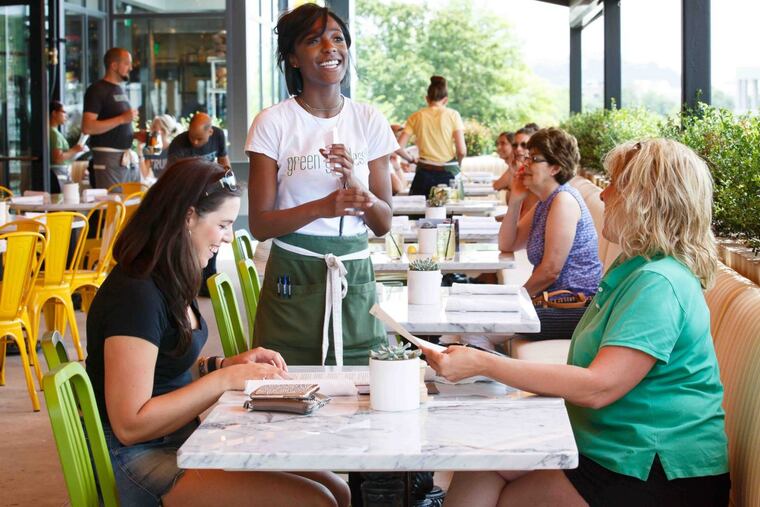Why True Food Kitchen took its kale and grass-fed beef to KOP Mall
How restaurant concepts like True Food Kitchen are becoming part of the evolving new mall and lifestyle center as traditional department stores and apparel retailers die off.

Not too long ago, mall owners feared that restaurants would siphon off too many parking spaces from avid shoppers, their main bread and butter.
Such conventional thinking has all been upended as department stores and traditional apparel retailers are fading and restaurants often become their replacements.
And if a brand is generating buzz, the mall owner may even give it land to build from the ground up — as was the case with Simon Property Group Inc., owner of King of Prussia Mall, and True Food Kitchen, a health-driven concept with an open kitchen, a focus on natural light and hospitality, and a seasonal menu loaded with fresh ingredients.
Fox Restaurant Concepts, owner of True Food, opened a 7,000-square-foot restaurant at 239 Mall Blvd. last month on prime land beside the mall.
"We look at a lot of locations where there are residents with active lifestyles, who are healthy eaters and appreciate the environment we are trying to provide," said Christine Barone, chief executive officer of True Food.
Barone was brought on last year from Starbucks, where she was senior vice president for food, the beer and wine program, and licensed stores. "Philly is really a place for us to expand and King of Prussia is the perfect first place in Pennsylvania to expand."
She came on board when there were a dozen True Food restaurants. Now there are 20, with the latest in King of Prussia.
"At True Food, you have a range from a kale salad and torched avocado to a grass-fed burger," she said. It's open from brunch through dinner and attracts guests "throughout the day, much like the mall."
Conceived in 2008 by restaurateur Sam Fox and holistic physician Andrew Weil in Phoenix, the brand has developed a following with locations in Southern California, Arizona, Georgia, and Maryland. A True Food just opened in Naples, Fla.
Fox, 48, conceived of several food concepts in Phoenix, including North Italia, the gastropub Culinary Dropout, and Doughbird, which combines pizza and rotisserie. Weil is a celebrity physician and author who melds alternative and mainstream medicine.
When you enter True Food, there are several ovens at work, including one for pizza, along with three giant blocks for preparing vegetables — giving customers a full view of meal preparation.
Deals like True Food at malls started about eight years go, but the trend has accelerated in the last four or five years, said David Orkin, restaurant practice leader for the Americas for commercial real estate firm CBRE Group Inc. True Food hired Orkin to help find locations east of the Mississippi.
"Malls are being re-tenanted, re-positioned, or downsized, and often restaurants are replacing old retailers, and the traffic and energy created by a 5,000-square-foot restaurant is greater than a 5,000-square-foot retailer," he said.
In True Food's case at KOP, "the restaurant's customer is the same one currently shopping at the mall — which is affluent, educated, health conscious."
Lars Kerstein, who brokered the True Food deal with King of Prussia Mall when he was with Metro Commercial, said he began scouting for sites in 2014.
"We originally started looking for sites in Center City around Rittenhouse, but ultimately going to KOP was an easier, quicker, and more down the middle opportunity than Rittenhouse," said Kerstein, now with Cedar Realty Trust.
Barone said many top mall developers — including Macerich, GGP Inc., and Westfield Corp. — were building more mixed-use developments, such as Legacy West, a shopping mall in Plano, Texas, featuring residential units and office spaces where True Food just opened.
Privately-held True Food doesn't release revenue figures, but Barone said, "we are expanding in all existing locations, as well as adding new markets."
Ditto for all Simon-owned malls. About 260 restaurants or quick-service dining options were added from 2011 to 2016, King of Prussia Mall general manager Bob Hart said.
The company also enhanced 23 dining pavilions by upgrading the ambiance and including healthier options. Six of the 23 dining pavilions were relocated and expanded.
Several restaurants have opened in the last two years at King of Prussia Mall, including Mistral, Grand Lux Café, and Cantina Laredo — bringing the mall's current full-service dining roster to 20. He said the mall dedicates more than 170,000 square feet of retail space to restaurants.
Having strong restaurants "energizes our loyal customers, attracts new audiences, and keeps shoppers at our centers longer," Hart said.
"Dining will continue to play a critical part of the social experience, with experiential and entertainment uses representing an important component of malls' future," said PREIT CEO Joseph Coradino.
That sounds like a good plan to Terri Wilson, who was lunching at Grand Lux Café at the Cherry Hill Mall last week with her former college roommate from Rowan University. They had just finished shopping at the Macy's there.
"Cherry Hill Mall is a more upscale mall, with the Nordstrom and the other upscale stores," said the high school English teacher at Gloucester County Institute of Technology. "They go hand in hand with the upscale restaurants."
Across the river, Barone's team is scouting for a downtown Philadelphia site for the region's second True Food. There's a similar stand-alone venue in Chicago and one in Bethesda, Md., which has a full block of windows.
Barone said an advantage to the KOP location is the amount of natural light streaming into the restaurant. The very open design is meant to bring in as much light as possible giving the customer a sense of being inside and outside at the same time.
"The height of the buildings, with lots of natural light, is the biggest challenge for us (in finding locations) in the city," Barone said. But "our transparency and ability to see into the kitchen is part of our brand."